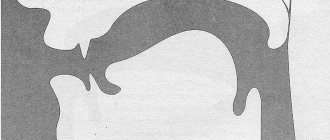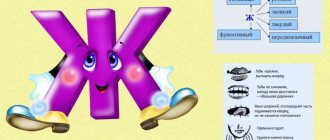Summary of individual speech therapy sessions. Automation of sound C
Summary of an individual speech therapy lesson on sound automation [C] in syllables, words and sentences
Author: Anastasia Igorevna Korogodina, teacher - speech therapist, Municipal preschool educational institution "Nursery - Garden No. 170 of the city of Donetsk" Description of work: this material will be useful for speech therapist teachers ; the material is intended for children 5 years old; This material is used in individual work on automating the sound “C” in syllables, words and sentences. Objectives: 1. Educational:
automation of the sound [S] in syllables, words and sentences.
2. Correctional:
• consolidate the skills of correct pronunciation of the sound [C] in syllables, words, sentences;
• develop articulatory and fine motor skills; • develop phonemic hearing; • develop speech breathing; • develop clarity of diction and intonation expressiveness. 3. Developmental:
• consolidate the ability to determine the place of a sound in a word;
• develop attention, memory, thinking; • practice the ability to complete a sentence grammatically correctly. 4. Educational:
• create positive motivation in the classroom;
• develop verbal communication skills and listening skills. Equipment: “Sonya the Dog” toy, “Su-Jok” massager, incentive sticker. Progress of the lesson 1. Organizational moment. Breathing exercises. Speech therapist: The bell gave us a signal: The hour has come to work. So we don’t waste time and start working. — inhale deeply through your nose, exhale through your mouth, inhale and exhale deeply again. 2. Articulation gymnastics. 1. “Smile” / “Tube” Holding your lips in a smile.
The teeth are not visible. Pulling closed lips forward. Once again. If our lips smile, Look - a fence appears.
Well, if the sponges are a narrow tube, then we can play the pipe. 2. “Clock” / “Pendulum” The mouth is slightly open.
The lips are stretched into a smile. With the tip of the narrow tongue, alternately reach to the corners of the mouth at the teacher’s count. One after another, one after another, the arrows go around in a circle.
You lick both lips, show how the arrows move. 3. “Punish the naughty tongue.” Smile widely.
Place your wide tongue on your lower lip and, lightly biting it with your teeth, say “ta-ta-ta” for 5-10 seconds. Then slap your tongue with your lips, saying “five-five-five” for 5-10 seconds. Your tongue is a mischief maker, It doesn’t listen to you.
Punish him quickly: “Five-five, five-five, five-five-five!” 4. “Pancake” The mouth is open, a wide, relaxed tongue lies on the lower lip.
We slap the tongue with our upper lip: five-five-five. We slightly bite our tongue: ta-ta-ta. In the morning we get up early and bake delicious pancakes.
The dough spreads like a stream across the frying pan... Look how beautiful the Pancake turns out. 5. “Brush your teeth” Smile, open your mouth with the tip of your tongue from the inside, “brush” the lower and upper teeth alternately.
Open your mouth, smile, show me your teeth, brush the upper and lower ones, because they are not superfluous.
6. “Gorka” Open your mouth.
Place the tip of your tongue against your lower teeth and lift the back of your tongue up. The tongue is lowered by the teeth, Its tip is pressed against the teeth.
The back arches very, very strongly - That's what a slide it turns out to be! 7. “Pussy is angry” Smile, open your mouth.
The tip of the tongue rests on the lower teeth from the inside (“mountain”). Roll out the wide tongue forward and move it deep into the mouth (slide). Repeat the exercise 8-10 times at a calm pace. Our pussy got angry: They forgot to wash her bowl.
Don't come close to her - her pussy might scratch her! 3. Finger gymnastics. Speech therapist: Look who came to us today! Who is this? This is a dog. What's the dog's name? Do not you know? I do not know either. Let's ask. Her name is Sonya. Let's introduce ourselves to Sonya, she's wondering who she'll be playing with today. Sonya loves to play with the ball. And now, we will show her how you can do it. Finger play with a “su-jok” massager.
I roll the ball in circles, I kick it back and forth.
I will stroke their palm. It’s as if I’m sweeping up a crumb, And I’ll squeeze it a little, Like a cat squeezes its paw, I’ll press the ball with each finger, And I’ll start with the other hand. Massage the fingers with an elastic ring “su-jok”.
One - two - three - four - five, /extend your fingers one at a time/ Let your fingers go out for a walk, This finger is the strongest, thickest and largest.
This finger is for showing it. This finger is the longest and stands in the middle. This ring finger is the most spoiled one. And the little finger, although small, is very dexterous and daring. 4. Articulatory image of sound. Speech therapist: Let's remember what position our lips, teeth and tongue occupy when pronouncing the sound “C”. The lips are stretched into a smile. The teeth are brought together and create a barrier to the air stream. The tip of the tongue rests on the lower teeth. 5. Pronunciation of an isolated sound [C]. Speech therapist: The dog Sonya really loves it when a cool breeze blows. Blow like a breeze S-S-S. 6. Physical education minute. We will blow high: S-S-S (The child stands on his tiptoes, raises his arms up) We will blow low: S-S-S (The child squats) We will blow far: S-S-S (The child straightens up, leans forward, arms outstretched ) We will blow close: S-S-S (Standing straight, hands raised to mouth) 7. Development of phonemic hearing. Speech therapist: Clap when you hear the sound “C”. P M S S A U K D S T S B SA MA SO BO SY AS YOU SU GI JUK SOUP SON HOUSE GARDEN SAM NOSE 8. Automation of sound (C) in pure language. Speech therapist: Imagine, our Sonya was bitten by a wasp. Now she is not friends with her. And you and I must reconcile them. We will repeat all the syllables, we will win this quarrel. SA-SA-SA, SA-SA-SA - a wasp bit me on the nose. SO-SO-SO, SO-SO-SO - my nose became like a wheel. SU-SU-SU, SU-SU-SU - I carry a wasp in my hand. SY-SY-SY, SY-SY-SY - I'm not afraid of the evil wasp. 9. Automation of sound (C) in words and sentences. Speech therapist: And now we will play the game “Sound Closet”. Name all the words. Make sure you pronounce the sound correctly.
Speech therapist: Look at the picture and say what the dog Sonya saw. Answer in a complete sentence. The dog Sonya saw...
10. Summary of the lesson. Speech therapist: What did you like most? Who did you play with today? What is the dog's name? 11. Assessment of the child’s speech activity. Speech therapist: You did great today, you pronounced the sound [S] correctly. Speech therapist: And Sonya also liked the way you played with her and performed various tasks. For this she wants to thank you and give you this sticker as a souvenir. Well done! References. 1. Yavorskaya O. N. Entertaining tasks of a speech therapist for preschoolers. – St. Petersburg: KARO, 2015. 2. Agranovich Z. E. Collection of homework for overcoming the underdevelopment of the phonemic aspect of speech in older preschoolers. To help speech therapists and parents. - St. Petersburg, 2007. 3. Zhukova N. S. Speech therapist lessons: correction of speech disorders. – M.: Eksmo, 2013. 4. Iskhanova S.V. Game therapy in speech therapy: articulatory transformations. – Rostov n/a: Phoenix, 2013.
We recommend watching:
Summary of an individual lesson on differentiating the sounds S and T for children 5-6 years old Summary of subgroup correctional activities of a speech therapist teacher with children of the senior group with FFND Summary of a speech therapy lesson in the middle group of a kindergarten: Sound and the letter P Structure of a speech therapy lesson on sound automation. Correction of sound pronunciation.
Similar articles:
Musical lesson using logorhythmics in the senior group of a preschool educational institution
How to teach a child to pronounce the letter C?
The first step towards a solution should be taken towards finding the source of the problem, because teaching a child to say the letter C is possible only after the reason for the incorrect sound production has been identified.
Incorrect pronunciation
Reasons for difficulty
You need to pay attention to pronunciation from the age of 3. Most often, by the age of 4, the child himself corrects whistling, hissing and even [P]. If this does not happen, you need to think about the possible reasons for the delay in speech improvement:
- age-related imperfection of the speech apparatus;
- the child grows up in a family where two languages are actively used;
- flaccid tongue muscle;
- malocclusion;
- anatomical features of the tongue;
- presence in the family of people with incorrect pronunciation;
- incorrect phonemics.
Attention! If the family is bilingual, the child may borrow sounds from one language and use them in the other. Thus, the interdental sound from the English language becomes an everyday substitute for Russian [S].
A weak tongue muscle, as a cause of incorrect pronunciation, can be corrected through training. Performing simple but effective exercises will help strengthen it. At home with your child, you should play with horses more often, imitating the sound of clopping hooves. If you perform the exercise several times a day until a feeling of fatigue appears in the tongue, the muscle will quickly become stronger.
Exercise to strengthen the tongue muscle
Why does FFNR occur?
The problem of FFND affects almost a quarter of all babies. Speech underdevelopment begins to manifest itself in the first years of life, when the child learns to pronounce words. For children 2-3 years old, the problem is not critical and does not require adult intervention. In order for speech to develop in accordance with the child’s age-related abilities, you need to carefully monitor your articulation. Adult speech should not be hasty or unclear. The formation of his phonemic representation of his native language depends on how the child hears words.
Phonetic-phonemic underdevelopment of speech is manifested in the incorrect pronunciation of some letters, mainly paired consonants (t-d), by replacing complex ones with simple ones (l-r). When a child cannot distinguish sounds from a word by ear, does not perceive the difference in consonant syllables, distorted speech is formed.
Attention! If this defect is not corrected by the age of 5-6 years, it will develop into incorrect written representation of words. Children who have not been treated to correct the perception of sound by ear and its pronunciation develop dysgraphia - erroneous spelling of words, accompanied by a stable replacement of syllables in a word, and rearrangement of letters.
Causes, diagnosis and clinical picture of mental retardation in ICD 10 coding in children
Preparation of the speech apparatus at home
The sound [C] is introduced in stages; classes begin with mastering the motor abilities of the tongue, which will definitely be useful for clear pronunciation of other sibilants.
Articulatory gymnastics for sounds (s, s, z, z, z)
Before you teach your child to say the letter C at home, he needs to be trained to control his tongue. A fun exercise called "Turkey". The child is told a random short rhyme about a poultry yard, after which he is asked to reproduce a turkey babble: it looks like the combination “bl-bl-bl”, but the tongue should be sharply thrown forward behind the teeth and come back, as if lining the upper lip from the inside and outside alternately.
Exercise "Turkey"
Attention! The “horse” exercise is highly effective, during which the child, sucking and lifting his tongue from the palate, imitates the clicking of hooves.
Finger exercises
Finger gymnastics brings the speech centers of the brain into an active phase, which has a positive effect on the development of speech, therefore rhythmic rhymes like “Forty-forty cooked porridge” are important in the development of pronunciation. Be sure to play for 5 minutes every day.
Working on breathing
The stages of teaching preschoolers the correct sound pronunciation include mandatory breathing work. The child needs to be taught to exhale air forcefully; to do this, a piece of paper or a “spinner” toy is placed at a short distance from him, which begins to move when there is a strong gust of air flow. The child should blow forcefully at the target, pursing his lips like a tube.
Another important lesson in breathing control is to control the rise and fall of the chest as you inhale and exhale. To turn the exercise into a game, you can place a tennis ball on your chest. When you exhale sharply, it will fall. The goal of the exercise is to throw the ball off your chest as many times as possible.
Mimic gymnastics for sound production [C]
Lessons on facial expressions with a speech therapist to pronounce the letter C are based on stretching the lips in a smile and slightly open teeth. If the lesson is held in a group of children, a competition is announced for the widest smile that will last longer than the rest.
Attention! An indicator of a correctly performed exercise will be a slight pain in the facial muscles on the cheeks.
Learning to pronounce “S” at home
In home classes, you can use popular notes from speech therapists for preschool age. They contain both written descriptions of the exercises and pictures to make the technique easier to understand.
Note to parents: A. I. Bogomolova’s manual.
The speech therapy manual by the author Bogomolova for classes with children contains a set of exercises aimed at correct articulation and breathing. The book includes a description of a technique that technically helps to put the tongue in place. The author recommends using a thin stick, similar to those left over from a popular candy: the child rests the tip of the tongue against the lower incisors, the tube is placed to the middle of the tongue, along, forcing it to form a groove, the lips stretch, as if smiling, in order to learn to pronounce the letter C.
Tongue placement
Phonemics: learning to hear
Classes on sound production [C] begin with correct auditory perception. From the first minutes of the lesson, they do not name the letter, but imitate the sound of the wind, flowing water, you can combine two letters K and C and call the cat: “ks-ks”. Hearing the sound correctly will help ensure clear pronunciation. A useful exercise would be random hearing testing, when an adult pronounces a set of syllables, among which there are no consonant sibilants. The test taker is asked to clap his hands when he hears a syllable involving S.
Breathing exercises for 1st and 2nd junior groups of preschool educational institutions
Sound production: pronounce it correctly
At home, when teaching your child the correct pronunciation, it will be useful to arm yourself with a mirror in which two reflections are placed: an adult and a child. It is easier for a child to repeat when he sees the adult’s correct articulation and the result of his efforts. He will independently understand the incorrect position of the tongue and will be able to control its location.
Speech therapy exercises
Speech therapy exercises for pronunciation of the letter C are aimed at training the correct position of the tip of the tongue - it should rest against the lower incisors and not rise above them:
- pronounce “Ihi” repeatedly in a whisper, after 10-15 repetitions, close your teeth and repeat again, then try to pronounce “carry”;
- practice pronunciation C by completely closing your teeth;
- in front of the mirror, observe the movement of the tongue when alternately pronouncing S and Sh in order to understand the difference.
Exercise with a mirror








